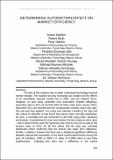Determining Automation effect on market efficiency

View/
Publication Date
2013-11-30Author
Asewe Stephen, Robert Mule, Peter Ndichu, Fredrick O Aila, Alecia E Okungu, Micheal M Michoki, Dancan M Onchonga, Gideon Momanyi
Metadata
Show full item recordAbstract/
The aim of this research was to better understand technology-induced
market changes. The Nairobi Security Exchange was studied and the effects
of an automation exercise carried out in 2006, was the research focus.
Adoption of case study unraveled how automation impacts efficiency.
Secondary data in form of monthly NSE-20 share index from January 2001-
December 2011 and transformed into compounded monthly return was used.
Run test was then applied. Too many runs indicate a tendency for high and
low values to alternate; it was found that returns were normally distributed.
As such, a normality test was conducted on the NSE using mean, skewness
and kurtosis. Considering the mean and median, the two measures were close
, and in almost all the years the skewness was close to zero (0) as well as the
kurtosis close to three (3) all this shows that the data was normally
distributed which confirmed that the market was weak form efficiency.
Finally, t statistics showed that there was a statistical significant difference
between manual and automation in the stock market performance during the
year of transition, 2005 to 2006 a P value of 0.0006 when it was fully
implemented, implying that there was a difference in the market
performance before and after market automation. These findings are meant
to provide an understanding of the automation implication undertaken by
market authorities that’s CMA and NSE on the market performance. It will
assist investors to develop strategies relating to their operational
environment.
